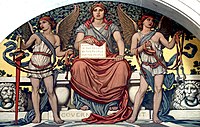
Photo from wikipedia
The main purpose of the study is to investigate the short run and long run relationship between government revenues and government expenditures in Bahrain over the period from 1990 to… Click to show full abstract
The main purpose of the study is to investigate the short run and long run relationship between government revenues and government expenditures in Bahrain over the period from 1990 to 2017. Using annual data and time series analysis, the study indicated that the above two variables, government revenues and government expenditures were integrated of order one when both Augmented Dickey-Fuller (ADF) and Phillip-Perron (PP) unit root tests were applied. The empirical results have revealed that unidirectional causality runs from government revenues to government expenditures. Thus, there is evidence in support of “revenue-spend” hypothesis. Finally, the results revealed that a 1% increase in oil revenue induces an increase in government expenditures by 1.37%. Therefore, policymakers in Bahrain should focus to further diversify the sources of government revenues from non-oil sectors in such a way that the country will be immune to vulnerability, especially when world oil market performs poorly.
Journal Title: International Journal of Energy Economics and Policy
Year Published: 2018
Link to full text (if available)
Share on Social Media: Sign Up to like & get
recommendations!